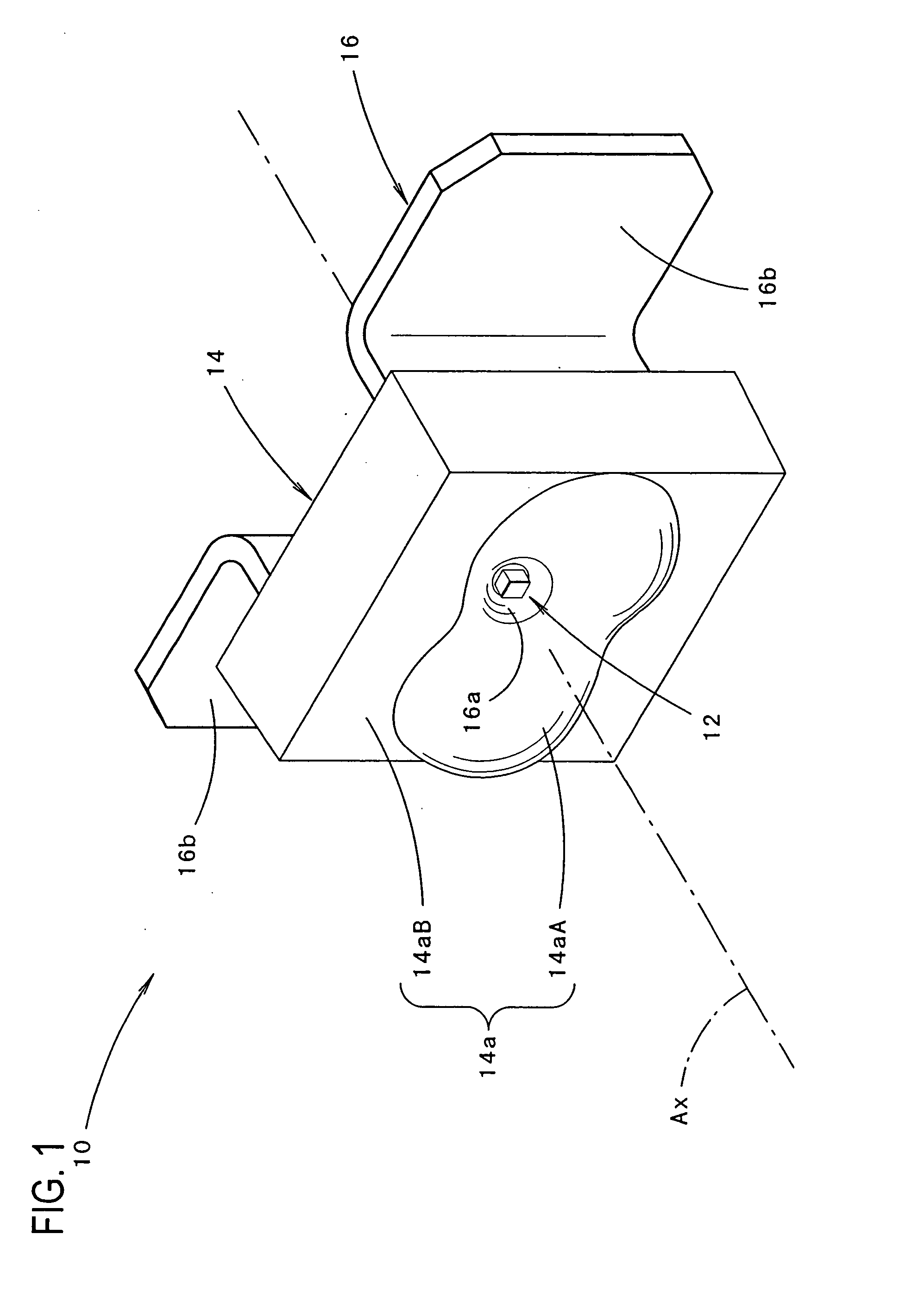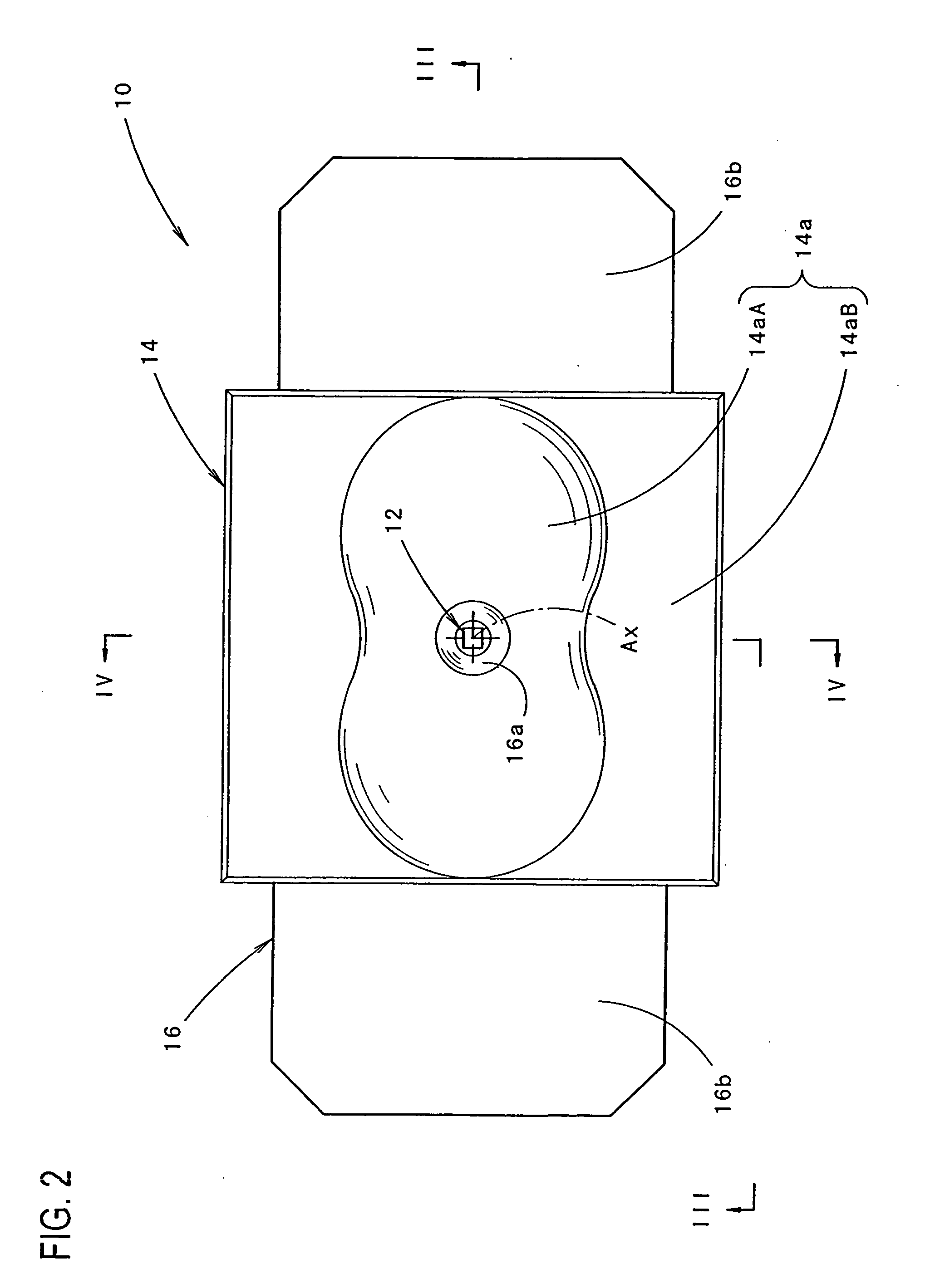Light-emitting diode and vehicular lamp
- Summary
- Abstract
- Description
- Claims
- Application Information
AI Technical Summary
Benefits of technology
Problems solved by technology
Method used
Image
Examples
first embodiment
[0049] the present invention will be described first.
[0050]FIG. 1 is a perspective view of the light-emitting diode 10 according to the first embodiment, and FIG. 2 is a front view thereof. FIG. 3 and FIG. 4 are the cross-sectional views taken along the line III-III and line IV-IV in FIG. 2, respectively.
[0051] As seen from FIGS. 1 through 4, the light-emitting diode 10 is comprised of a light-emitting chip 12 disposed on a predetermined optical axis Ax, a transparent sealing member 14 that seals the light-emitting chip 12 on the side that faces the forward direction along the optical axis Ax (which will simply be referred to as “front side” hereafter), and a lead frame 16 for supporting the light-emitting chip 12.
[0052] The light-emitting chip 12 has a light emitting face of around 0.3 to 1 mm square and is disposed with its light emission center O positioned on the optical axis Ax and with its light emitting face facing toward the front face (i.e., in the forward direction along...
second embodiment
[0087] Though in the above-described vehicular lamp 50 the parallel light is diffused in the vertical direction and the lateral direction by the outer lens 36 after the light emitted from the light-emitting element 10 is adjusted so as to be parallel light fluxes, other arrangements are possible so that the front face of the inner lens 34 has such a diffusion function as described above while the outer lens 36 has a plain lens function and so that the outer lens 36 is omitted. Next, the second embodiment according to the present invention will be described.
[0088]FIG. 12 is a perspective view of the light-emitting diode 110 of the second embodiment, and FIG. 13 is a front view thereof FIG. 14 and FIG. 15 are cross-sectional views taken along the line XIV-XIV and line XV-XV in FIG. 13, respectively.
[0089] As seen from FIGS. 12 through 15, the light-emitting diode 110 has the same basic configuration as that of the light-emitting diode 10 of the above-described first embodiment. The c...
third embodiment
[0095] Next, the present invention will be described below.
[0096]FIG. 16 shows a light-emitting diode 210 of the third embodiment.
[0097] As seen from FIG. 16, the light-emitting diode 210 has the same basic configuration as that of the light-emitting diode 10 of the first embodiment. The front face 214a of the sealing member 214 of the light-emitting diode 210, however, differs from that of the first embodiment.
[0098] In other words, the front face 214a of the sealing member 214 has a curved surface portion 214aA and a deflection directing portion 214aB.
[0099] The curved surface portion 214aA is formed as a surface of revolution, in which the undulating curve, which forms the cross-sectional shape of the curved surface portion 14aA of the front face 14a of the sealing member 14 taken along the horizontal plane that includes the optical axis Ax of the first embodiment, is rotated about the optical axis Ax.
[0100] The deflection directing portion 214aB is formed by a circular stepp...
PUM
 Login to View More
Login to View More Abstract
Description
Claims
Application Information
 Login to View More
Login to View More - R&D
- Intellectual Property
- Life Sciences
- Materials
- Tech Scout
- Unparalleled Data Quality
- Higher Quality Content
- 60% Fewer Hallucinations
Browse by: Latest US Patents, China's latest patents, Technical Efficacy Thesaurus, Application Domain, Technology Topic, Popular Technical Reports.
© 2025 PatSnap. All rights reserved.Legal|Privacy policy|Modern Slavery Act Transparency Statement|Sitemap|About US| Contact US: help@patsnap.com



